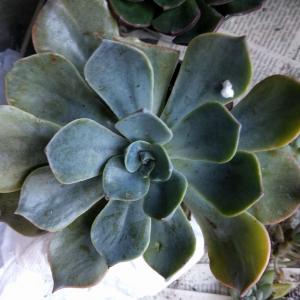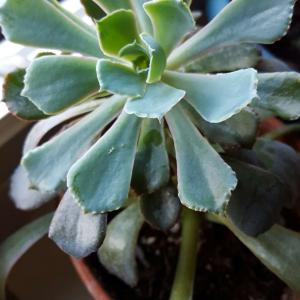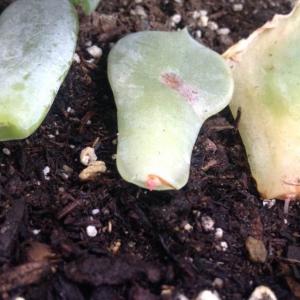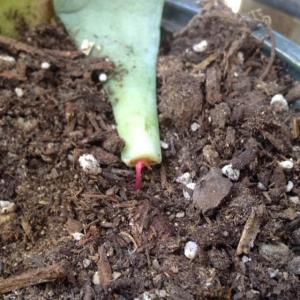文章
Dummer. ゛☀
2017年09月26日

Scientific Name
Echeveria globulosa Moran

Scientific Classification
Family: Crassulaceae
Subfamily: Sedoideae
Tribe: Sedeae
Subtribe: Sedinae
Genus: Echeveria

Flower
Color: Оrange-yellow
Bloom Time: Spring to fall
Description
Echeveria globulosa is a cute succulent plant with compact rosettes with fleshy, pointed leaves. Spreads easily to form a low growing, compact clump or cluster. The rosettes are up to 2 inches (5 cm) in diameter and the cluster won’t grow taller than 6 inches (15 cm). Leaves are a pale blue and can be blushed with pink. Brightly colored orange-yellow flowers grow on short stems above the rosettes.

How to Grow and Care
Most of the common Echeveria species are not complicated succulents to grow, provided you follow a few basic rules. First, be careful never to let water sit in the rosette as it can cause rot or fungal diseases that will kill the plant. Additionally, remove dead leaves from the bottom of the plant as it grows. These dead leaves provide a haven for pests, and Echeveria are susceptible to mealy bugs. As with all succulents, careful watering habits and plenty of light will help ensure success.
Repot as needed, preferably during the warm season. To repot a succulent, make sure the soil is dry before repotting, then gently remove the pot. Knock away the old soil from the roots, making sure to remove any rotted or dead roots in the process. Treat any cuts with a fungicide. Place the plant in its new pot and backfill with potting soil, spreading the roots out as you repot. Leave the plant dry for a week or so, then begin to water lightly to reduce the risk of root rot.
Most Echeveria can be easily propagated from leaf cuttings, although a few are better from seeds or stem cuttings. To propagate a leaf cutting, place the individual leaf in a succulent or cacti mix and cover the dish until the new plant sprouts.
Origin
Native to Mexico (Oaxaca).
Echeveria globulosa Moran

Scientific Classification
Family: Crassulaceae
Subfamily: Sedoideae
Tribe: Sedeae
Subtribe: Sedinae
Genus: Echeveria

Flower
Color: Оrange-yellow
Bloom Time: Spring to fall
Description
Echeveria globulosa is a cute succulent plant with compact rosettes with fleshy, pointed leaves. Spreads easily to form a low growing, compact clump or cluster. The rosettes are up to 2 inches (5 cm) in diameter and the cluster won’t grow taller than 6 inches (15 cm). Leaves are a pale blue and can be blushed with pink. Brightly colored orange-yellow flowers grow on short stems above the rosettes.

How to Grow and Care
Most of the common Echeveria species are not complicated succulents to grow, provided you follow a few basic rules. First, be careful never to let water sit in the rosette as it can cause rot or fungal diseases that will kill the plant. Additionally, remove dead leaves from the bottom of the plant as it grows. These dead leaves provide a haven for pests, and Echeveria are susceptible to mealy bugs. As with all succulents, careful watering habits and plenty of light will help ensure success.
Repot as needed, preferably during the warm season. To repot a succulent, make sure the soil is dry before repotting, then gently remove the pot. Knock away the old soil from the roots, making sure to remove any rotted or dead roots in the process. Treat any cuts with a fungicide. Place the plant in its new pot and backfill with potting soil, spreading the roots out as you repot. Leave the plant dry for a week or so, then begin to water lightly to reduce the risk of root rot.
Most Echeveria can be easily propagated from leaf cuttings, although a few are better from seeds or stem cuttings. To propagate a leaf cutting, place the individual leaf in a succulent or cacti mix and cover the dish until the new plant sprouts.
Origin
Native to Mexico (Oaxaca).
4
2
文章
Dummer. ゛☀
2017年09月26日

Scientific Name
Echeveria elegans Rose

Common Names
Mexican Snow Ball, Mexican Snowball, Mexican Gem, White Mexican Rose, Hens and Chicks, Pearl Echeveria
Synonyms
Echeveria tinctoria, Echeveria tinctorum
Scientific Classification
Family: Crassulaceae
Subfamily: Sedoideae
Tribe: Sedeae
Subtribe: Sedinae
Genus: Echeveria

Flower
Color: Pink and yellow
Bloom Time: Late winter and spring
Description
Echeveria elegans is a stemless or short-stemmed, clump-forming succulent evergreen perennial, growing up to 4 inches (10 cm) tall and up to 20 inches (50 cm) wide, with tight rosettes of pale green-blue fleshy leaves, bearing up to 10 inches (25 cm) long slender pink stalks of pink flowers with yellow tips in late winter and spring.

How to Grow and Care
Most of the common Echeveria species are not complicated succulents to grow, provided you follow a few basic rules. First, be careful never to let water sit in the rosette as it can cause rot or fungal diseases that will kill the plant. Additionally, remove dead leaves from the bottom of the plant as it grows. These dead leaves provide a haven for pests, and Echeveria are susceptible to mealy bugs. As with all succulents, careful watering habits and plenty of light will help ensure success.
Most Echeveria can be easily propagated from leaf cuttings, although a few are better from seeds or stem cuttings. To propagate a leaf cutting, place the individual leaf in a succulent or cacti mix and cover the dish until the new plant sprouts. Repot as needed, preferably during the warm season. To repot a succulent, make sure the soil is dry before repotting, then gently remove the pot.
Origin
Native to semi-desert habitats in Mexico.
Echeveria elegans Rose

Common Names
Mexican Snow Ball, Mexican Snowball, Mexican Gem, White Mexican Rose, Hens and Chicks, Pearl Echeveria
Synonyms
Echeveria tinctoria, Echeveria tinctorum
Scientific Classification
Family: Crassulaceae
Subfamily: Sedoideae
Tribe: Sedeae
Subtribe: Sedinae
Genus: Echeveria

Flower
Color: Pink and yellow
Bloom Time: Late winter and spring
Description
Echeveria elegans is a stemless or short-stemmed, clump-forming succulent evergreen perennial, growing up to 4 inches (10 cm) tall and up to 20 inches (50 cm) wide, with tight rosettes of pale green-blue fleshy leaves, bearing up to 10 inches (25 cm) long slender pink stalks of pink flowers with yellow tips in late winter and spring.

How to Grow and Care
Most of the common Echeveria species are not complicated succulents to grow, provided you follow a few basic rules. First, be careful never to let water sit in the rosette as it can cause rot or fungal diseases that will kill the plant. Additionally, remove dead leaves from the bottom of the plant as it grows. These dead leaves provide a haven for pests, and Echeveria are susceptible to mealy bugs. As with all succulents, careful watering habits and plenty of light will help ensure success.
Most Echeveria can be easily propagated from leaf cuttings, although a few are better from seeds or stem cuttings. To propagate a leaf cutting, place the individual leaf in a succulent or cacti mix and cover the dish until the new plant sprouts. Repot as needed, preferably during the warm season. To repot a succulent, make sure the soil is dry before repotting, then gently remove the pot.
Origin
Native to semi-desert habitats in Mexico.
2
2






















